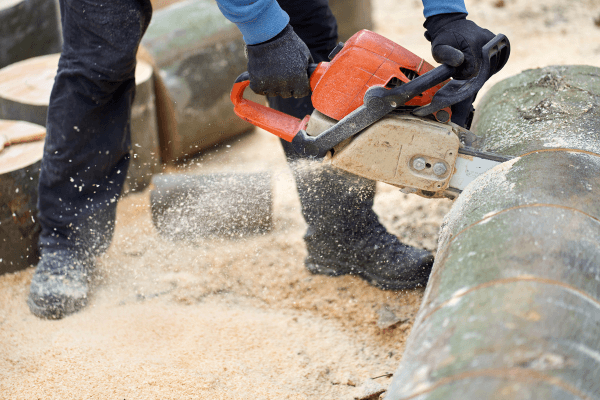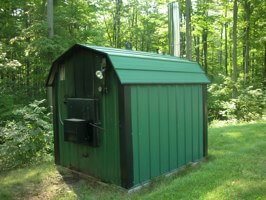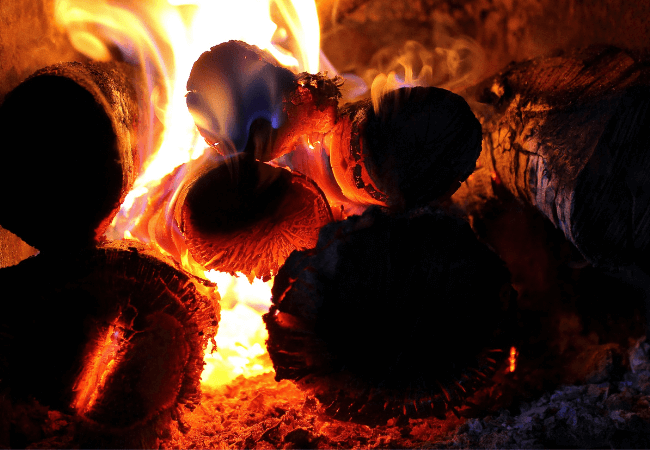- Home
- Wood Stove Guide
- Outside Wood Burning Stoves
Outside Wood Burning Stoves
This post may contain affiliate links so I earn a commission.
Outside wood burning stoves offer a great way to heat your entire home and additional outbuildings with firewood without the mess commonly associated with indoor units.
Plus, as an added benefit, an outdoor stove has a very large firebox which typically only requires you to add firewood twice a day, once in the morning and once in the evening.
This greatly reduces the amount of time you spend tending to your fire.
One of the biggest complaints customers have with outdoor stoves are their efficiency levels.
Older models generally heat large amounts of water and do not contain secondary combustion technology like newer wood stoves.
These older units burn a lot of firewood and smoke like a freight train causing many communities to prohibit their use do to the large amount of smoke they create.

I bought my first outdoor wood stove in 2005 before newer EPA regulations were in effect.
My original outdoor stove would burn about 10-12 full cords of firewood a year.
That's a lot of firewood to cut and haul every year.
However, just as indoor wood stoves have evolved since 2005, so have the outdoor models.
Now, these newer models have drastically improved in efficiency which also reduces smoke and firewood consumption.
New EPA regulations and technology have created a whole new market for these stoves, and they're definitely an option you should consider if you want to heat your home with firewood.
Older Outside Wood Burning Stoves
The older outdoor stoves are pretty simple in design.
They consist of a firebox that's surrounded by a water jacket.
Then, the whole firebox and water jacket is enclosed by a shed to keep it protected from the weather.
The fire inside the firebox heats the water contained in the water jacket (usually around 200-400 gallons) which is moved through underground pipes using a circulation pump.
This hot water circulates through a heat exchanger which in turn supplies the heat to your forced air or hot water heating system.
 Older Pre EPA Certified Stove
Older Pre EPA Certified StoveThe hot water from the wood stove never mixes with the hot water inside your home.
They are separate systems that use the heat exchanger to transfer the heat.
Multiple ports on the stove can heat additional pole barns, hot tubs or they can also be plumed to heat your domestic hot water.
The basic functions of an older stove are pretty simple.
A damper on the front of the door opens and closes to keep the water temperature at a specific temperature regulated by an aquastat.
Since there's no secondary burn, any unused heat from the fire simply goes up and out of the chimney on the stove.
This is the main reason these outdoor wood furnaces burn such a large amount of firewood.
New Outside Wood Burning Stoves
In February 2015 the Environmental Protection Agency (EPA) made updates to residential clean air standards which included outside wood burning stoves.
These standards made outdoor wood stoves, also called outdoor wood furnaces or hydronic heaters, much more efficient.
Now, any outdoor stove sold after December 31, 2015 must meet the EPA's Step 1 emissions standards with further Step 2 regulations coming in 2020.

Today's stoves now feature high efficiency combustion that effectively burns leftover gasses that the older stoves could not process.
This gasification step on the newer stoves can reduce emissions by up to 90 percent causing your new stove to burn nearly half as much firewood as some of the older models.
Some newer models even have modulating components that allow the stove to burn at a temperature your home currently demands.
This constant burn without the continual shut down/start up of the older stoves helps reduce creosote and harmful emissions.
Outside Wood Burning Stoves - Overall
Although the old outdoor hydronic stoves are not very efficient, they still do a great job at effectively heating your home with firewood without constantly filling the stove with wood.
Plus it keeps the mess outside and off your floors.
The large firebox holds a lot of wood, which reduces the need to fill it more then a couple of times a day.
However, the amount of wood you'll need to cut each year is pretty extensive.
One positive feature on these stoves is the firewood really doesn't need to be split. If you can lift it, the stove will burn it.
If you're thinking about purchasing an outdoor wood stove today, I would definitely consider buying one of the newer EPA certified stoves instead of finding an older, used pre EPA certified wood furnace.
Not only will you reduce your carbon footprint, you'll also burn less wood which can really pay off in the future by saving you time and effort.

About the Author
Obsessed with firewood, Nick is behind over 350+ of Firewood For Life's articles, as well as countless reviews, guides and YouTube videos to help readers like you reduce heating costs and create the perfect fire.


